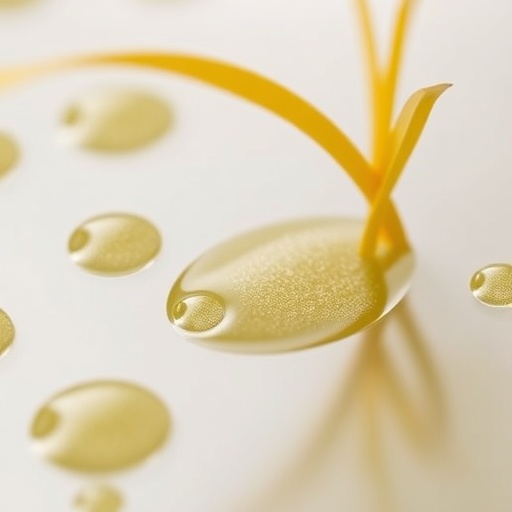Researchers across the globe are increasingly recognizing the potential of waste materials in creating sustainable solutions for various industrial applications. One intriguing study led by Manivannan, J., Mohan, N.S., and Arulraj, A. has shed light on a pioneering method of developing hydrophobic coatings using silica extracted from sugarcane bagasse ash. This innovative approach not only highlights the versatility of waste but also points towards a more sustainable future in materials science.
Sugarcane bagasse, the fibrous residue left after sugar extraction, is often overlooked and underutilized. However, it serves as an abundant source of silica, a compound that holds significant promise in the production of hydrophobic coatings. The process developed by these researchers emphasizes the importance of recycling agricultural waste. By converting what is typically regarded as a byproduct into a valuable raw material, the study contributes to the circular economy in agricultural practices.
The method entails a meticulous extraction process, wherein the silica is sourced from burned sugarcane bagasse. This ash, rich in silica, undergoes several steps of purification and transformation to yield a fine silica powder, suitable for coating applications. This process not only recycles waste but also reduces environmental impacts associated with conventional silica extraction methods, which often involve mining and extensive energy consumption.
Hydrophobic coatings are essential in various industries due to their ability to repel water and resist corrosion. These coatings can significantly enhance the durability and lifespan of materials, making them invaluable in construction, automotive, and even electronic applications. The silica extracted from sugarcane bagasse ash displays excellent hydrophobic properties, thereby positioning this new material as a formidable competitor to traditional hydrocarbon-based coatings.
The study carefully evaluates the performance of this sustainably sourced silica by testing its hydrophobic properties under various conditions. Hydrolysis, surface modification, and treatment techniques are examined to optimize the hydrophobic characteristics. The results indicate that these silica coatings exhibit remarkable contact angles against water, demonstrating superior water-repellency compared to conventional coatings. This success paves the way for broader industrial applications, signaling a shift towards environmentally friendly and sustainable practices in manufacturing.
The implications of utilizing sugarcane bagasse ash extend beyond just the production of coatings. This technique exemplifies how innovative thinking can transform agricultural waste into valuable resources, thus addressing the pressing issues of waste management and resource scarcity. With millions of tons of waste generated annually from the sugar industry, the potential for economic and environmental benefits becomes increasingly clear.
Moreover, using agricultural residues like bagasse not only supports sustainability but also enhances the livelihoods of farmers. By adding value to this waste, the agricultural sector can create new revenue streams, empowering local communities and fostering economic resilience. As such, this research may serve as a blueprint for similar initiatives in other regions and industries, reinforcing the importance of resourcefulness in the face of global sustainability challenges.
In light of climate change and environmental degradation, the urgency for sustainable solutions has never been more pronounced. The findings from Manivannan and his colleagues not only provide a step towards greener technologies but also inspire others in the field of materials science to explore innovative uses for waste products. This is crucial for driving the industry towards more environmentally-friendly alternatives and ensuring adherence to sustainability goals.
The researchers envision a future where the use of waste-derived materials becomes commonplace across various sectors. Continuing to refine the extraction and treatment processes may further encourage industries to adopt these sustainable methods. As technologies advance, the potential to scale up production and reduce costs may soon lead to widespread commercialization of hydrophobic coatings derived from sugarcane bagasse ash.
It is this sort of trailblazing research that showcases the synergy between scholarly innovation and ecological stewardship, providing a roadmap for the future of sustainable materials. By publishing their findings, the researchers aim to spark discussions within the scientific community and beyond, pushing for a more significant focus on waste valorization in research agendas.
Ultimately, the development of hydrophobic coatings from agricultural byproducts exemplifies a vital intersection between technology, sustainability, and economic growth. Through recognizing the potential of waste materials, the journey towards achieving a truly sustainable future can gather momentum, inspiring new generations of researchers and entrepreneurs alike to think outside the box. Such initiatives may ultimately play a significant role in combating climate change while fostering a circular economy.
With the study published in the prestigious journal, Waste Biomass Valor, it invites further exploration and replication of such efforts in various contexts. By establishing a solid foundation for future research, it encourages a robust network of scientists and industry players committed to turning waste into wealth—an essential endeavor in our rapidly changing world.
In conclusion, Manivannan, J. and his team present a compelling case for the innovative repurposing of sugarcane bagasse ash into hydrophobic coatings. This work stands as an example of how sustainability can be integrated into material development processes, pushing the boundaries of what is possible in both science and industry.
Subject of Research: Sustainable Development of Hydrophobic Coatings Using Silica Extracted from Sugarcane Bagasse Ash
Article Title: Sustainable Development of Hydrophobic Coatings Using Silica Extracted from Sugarcane Bagasse Ash
Article References:
Manivannan, J., Mohan, N.S., Arulraj, A. et al. Sustainable Development of Hydrophobic Coatings Using Silica Extracted from Sugarcane Bagasse Ash.
Waste Biomass Valor (2025). https://doi.org/10.1007/s12649-025-03411-z
Image Credits: AI Generated
DOI: https://doi.org/10.1007/s12649-025-03411-z
Keywords: Hydrophobic coatings, silica, sugarcane bagasse ash, sustainable materials, waste valorization.
Tags: circular economy in agricultureeco-friendly hydrophobic coatingsenvironmental impact reductionhydrophobic coating applicationsinnovative waste utilizationrecycling agricultural byproductsrenewable materials developmentsilica extraction from agricultural wastesilica powder production processsugarcane bagasse ashsugarcane industry sustainabilitysustainable materials science





